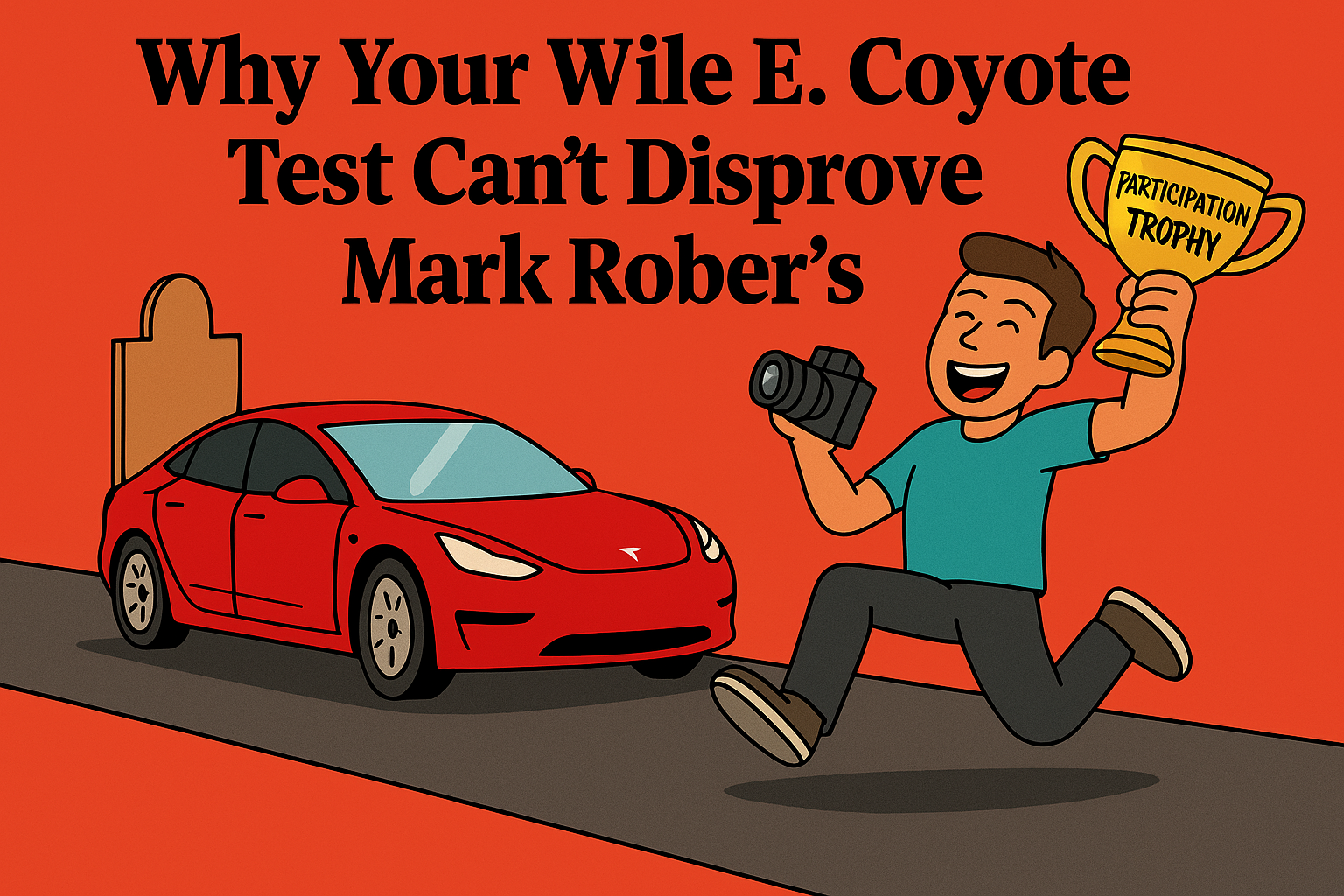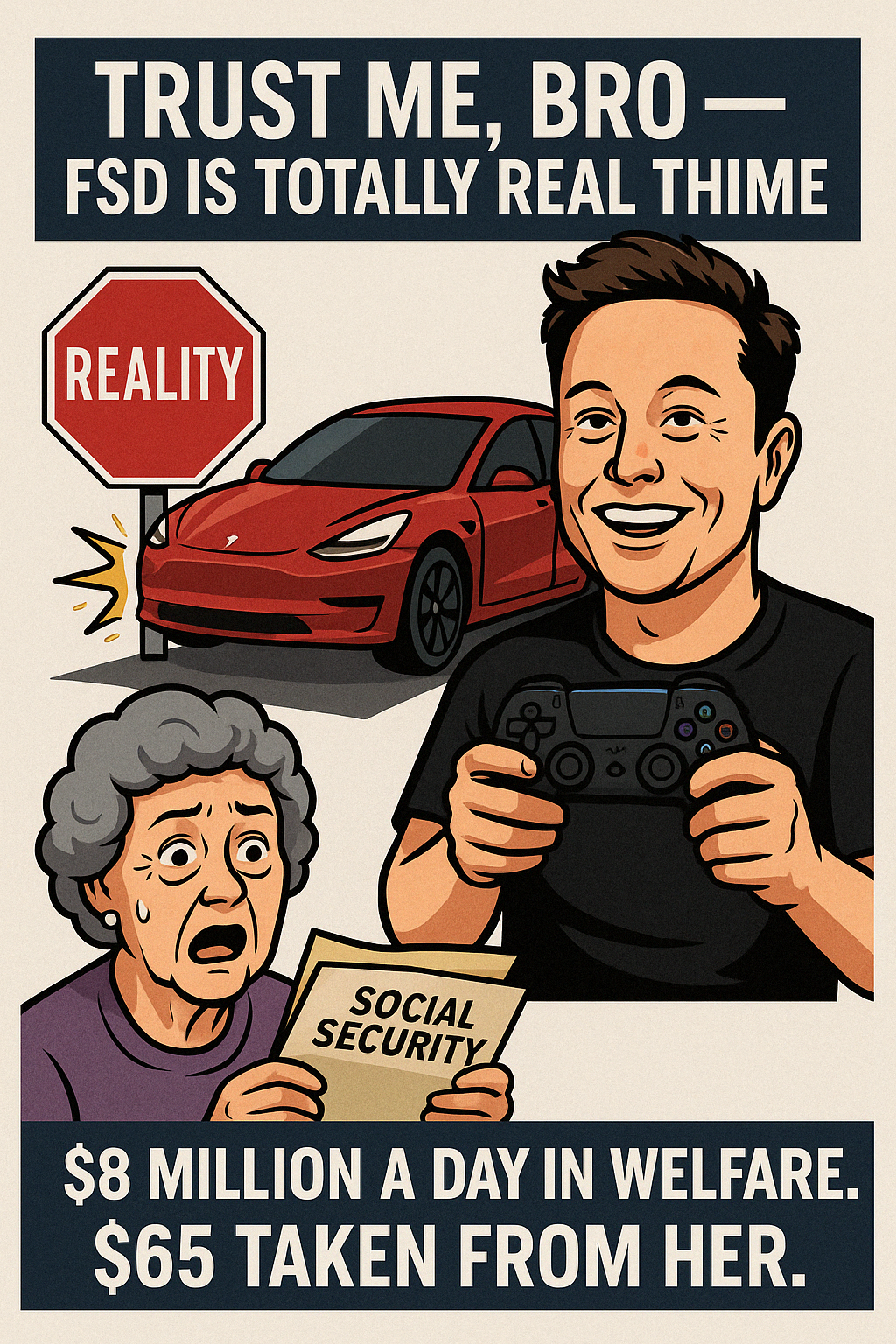If you’ve been anywhere near Twitter, Reddit, or YouTube since Mark Rober dropped his now-viral video exposing Tesla’s Full Self-Driving (FSD) system’s fatal flaws, you’ve probably seen the wave of fanboys scrambling to disprove it. Their approach? Posting videos of their own “Wile E. Coyote Tests” — carefully staged obstacle courses where the car doesn’t fail.
Here’s the problem: Their videos prove absolutely nothing.
In fact, their response itself is a logical fallacy — or actually, several of them at once.

Demonstration Is Not Validation
Let’s start with the most basic issue.
A single demonstration of FSD passing a test does not prove systemic safety.
It’s like saying you can prove Russian Roulette is safe because you pulled the trigger once and didn’t die.
Mark Rober’s test wasn’t meant to be a “gotcha” moment — it was a statistically normal, unplanned, uncontrolled test. It was representative of the chaos of the real world, where FSD is supposed to work all the time.
Passing a test in your driveway that you rehearsed 10 times is not the same as operating reliably in the real world across millions of miles.
They are confusing possibility with reliability.
It’s possible for FSD to pass that test once.
It’s an entirely different thing to prove that it can pass it every time, without exception, in the wild.
Misunderstanding Statistical Significance
Let’s talk numbers.
Human drivers average one crash every 500,000 miles.
That’s the benchmark. That’s what Tesla’s FSD has to exceed to claim it’s safer than a human.
So, if your car passes a staged Wile E. Coyote test once, or even ten times, what does that tell us?
Nothing.
It’s statistically irrelevant.
You’d need to pass that test hundreds of thousands of times without failure to start approaching human safety levels.
This is what’s known in logic as a Misunderstanding of Sample Size.
The plural of anecdote is not data.
Passing a test once is not proof of safety — it’s just a video.
Cherry-Picking and Confirmation Bias
The people posting these “gotcha” videos are also engaging in cherry-picking.
They select their best video, their cleanest run, and present it as proof.
They ignore the times it failed.
They ignore the times their own car required intervention, disengaged, or ran over cones.
It’s not proof — it’s a highlight reel.
Meanwhile, the real data tells a different story.
Tesla drivers have among the highest crash rates of any brand AND the most fatalities.
FSD has been implicated in hundreds of accidents and multiple fatalities.
No amount of cherry-picked obstacle courses will change that math.
Straw Man Arguments Everywhere
There’s also an undercurrent of Straw Man arguments in these defenses.
Mark Rober’s video wasn’t saying the car fails every time.
It wasn’t even saying the car is “bad” in the abstract.
The argument was simple: FSD failed an uncontrolled, real-world obstacle test. That failure rate is dangerous.
These “response videos” misrepresent the critique and knock down an easier target:
“See? It passed my test! Therefore, Rober is wrong!”
No. That’s not how reality works.
False Equivalence and Red Herrings
Even when the fan videos look similar, they are often not the same test.
They simplify the obstacle.
They use different materials.
They run the test in clear weather, in a clean, empty street, without pedestrians, without edge cases.
And even if the tests are technically the same, it doesn’t address the larger point:
Passing one test doesn’t invalidate failing another.
That’s like saying, “Well, I made it through one green light, so traffic accidents aren’t real.”
The Real Issue: Technology Limits
Here’s the truth these fan videos can’t erase:
Tesla FSD lacks redundancy.
It refuses to use LiDAR, radar, or anything beyond cheap cameras.
Every other serious autonomous driving company — Waymo, Cruise, you name it — uses multiple sensor types because they know what Tesla pretends isn’t true:
You can’t “AI” your way out of sensor limitations.
Vision-only driving will always fail sometimes.
Those failures can be fatal.
Passing a YouTube obstacle course doesn’t fix that.
Demonstration ≠ Validation
This is the key.
Demonstration is not validation.
You can rehearse a magic trick.
You can pass a stunt test.
You can cherry-pick a successful video.
But none of that validates FSD’s systemic safety.
Validation requires large-scale, uncontrolled, repeatable, statistically sound results — the exact opposite of what these “Look! It passed!” videos are.
The Reality
Here’s what’s really happening:
These fanboys aren’t defending technology.
They’re defending their stock bags.
Their social identity.
Their sunk costs.
If they admit that one test failure matters, the entire fantasy starts to fall apart.
But reality doesn’t care about their feelings.
Mark Rober’s test failure stands — because it reflects the real, uncontrolled world where FSD has to work.
And no amount of Wile E. Coyote obstacle courses will change that.
Discover more from
Subscribe to get the latest posts sent to your email.




